Everything we’ve examined so far in this Deconstructing Goldwork series has built up, in a way, to the final central element on the vestment, which is the Agnus Dei symbol.
So far in the series, we’ve looked at how this bunch of goldwork grapes was constructed, we examined the goldwork lily and the goldwork rose and took those apart to see their foundations and discover the methods with which they were made, we looked at simple goldwork leaves, and at shafts of goldwork wheat.
But all those little pieces – as interesting as they are – are not quite as complex as the focal point on the vestment, which is this symbol, the Agnus Dei:
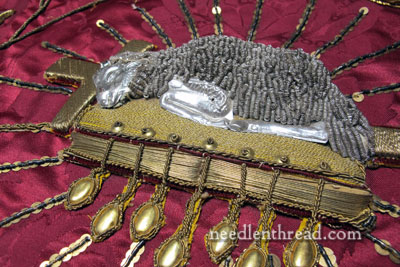
This Agnus Dei (meaning Lamb of God) is a Christian symbol dating from the first century that represents Christ as a lamb, or “the Lamb of God”. (Biblical references, from the Vulgate, include: John 1:29; John 1:36; Revelation 5:6, etc.)
In this particular image, the symbolism is sacrificial – the lamb is dead. In this Agnus Dei that I embroidered quite a while ago (and that I’d make some major changes on now, if I were doing it again!), the symbol is much more evocative of Easter, as the lamb is alive, supporting a banner that declares triumph over death.
In some depictions, the lamb is resting still on the book, but is alive with the head upright, often looking over the shoulder, as in this embroidered goldwork Agnus Dei, an image that depicts the triumph over death and also the notion (from the Vulgate, Revelation 6) of judgement.
So, in Christian symbolism, the Agnus Dei can be depicted different ways.
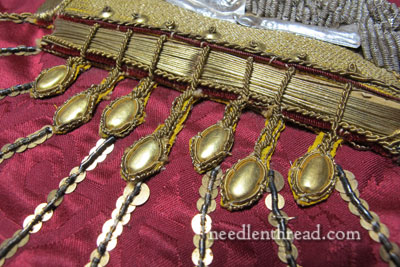
This particular piece on this particular vestment, I have no doubt, is a commercial appliqué. That is, it was made by a workshop that produced appliqués in quantity and sold them to vestment makers, rather than being made at the same workshop where the vestment was made, and hand embroidered specifically for this vestment. The vestment maker would have ordered the appliqué, already made, from some seller of ecclesiastical embroidery appliqués.
In fact, this is most likely the case for the other elements we’ve examined on this piece. I do not think this ground fabric is the original vestment the pieces were on – I think they were all (each piece) salvaged from another vestment and applied to a new ground fabric, but that initially, they were bought, pre-made, to be applied to vestments in general.
Later on, we’ll discuss why I think this, and I’ll support my opinion with evidence from our deconstructing project.
In the meantime, let’s look at the Agnus Dei up close.
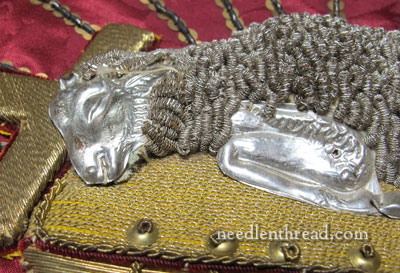
The lamb is resting on a book and a cross. The body of the lamb is constructed with tin-like molded parts (heads and leg) and silver bullion (which is similar to bright check purl, but a little looser and more open in twist).
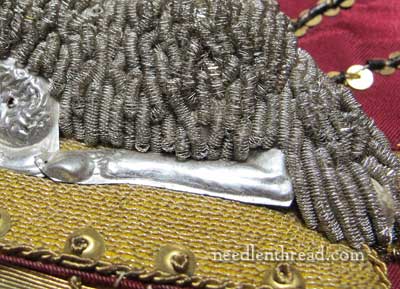
The molded parts are fairly well detailed, but when you look at them up close, you might think they look odd. I’ve seen much better molded lamb parts for this type of embroidery – parts that don’t have this overhanging flat edge all around them. If you look at this very similar Agnus Dei appliqué on Flickr, you’ll see that the molded parts are much more precisely cut. If you look around online, especially though Google images (searching antique or vintage Agnus Dei embroidery), you’ll see other similar images, where the molded parts look a little better.
In any case, these are meant to be seen from afar, and the detail would not be as evident from a distance.
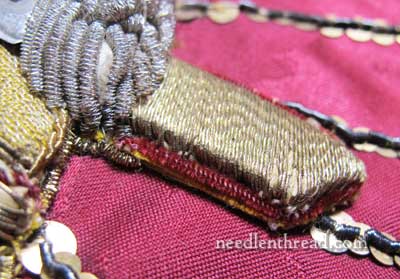
The cross is made from a fine, slightly wavy gold thread crossing over the “beams” on the diagonal, worked in the same manner that the gold was worked on the rose, lily, and leaves that we looked at previously.
Outlining the base of the goldwork around the cross is a thin, fuzzy thread in red – this is silk chenille, couched on and used as a “finish” on these edges. It looks kind of like a pipe cleaner in the photo – see it? It’s soft, though, not stiff.
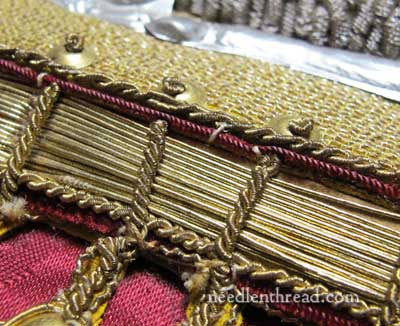
The book has a little piece of cloth of gold (some variety thereof) as the cover of the book (on which the lamb is resting), and the “pages” are gold passing thread, couched on each end and in the middle.
The seals drop down from the cover, across the pages, and the “cord” you see here is made of two strands of smooth purl with a string core that have been twisted together. This gives the look of “s-ing” with purl, but these rope-like cords are actually not individually stitched. They’re like a twisted thread, hanging from the top of the book to the base, and couched only where they begin (at the top of the book, under each of those gold spangles) and at the base of the book, right above where the seal is connected.
You can see that the book – just inside the top cover and the bottom cover – is also accented with a strand of couched silk chenille in red.
This part of the goldwork is pretty messy and in bad repair.
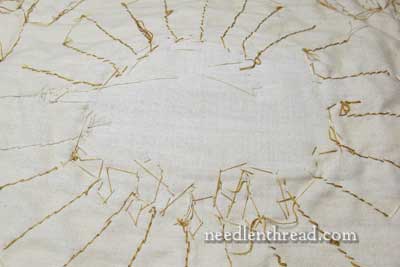
Let’s look at the back! You can see the shape of the appliqué, and the threads from the rays (which are made from spangles and purl s-ing) radiating from the area where the appliqué is sewn down.
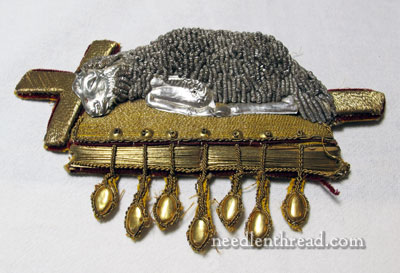
And here is the appliqué, removed.
We’ll deconstruct the entire appliqué, step by step, to see how it is built up. This is truly “dimensional” embroidery – the whole piece is built on foundations upon foundations, and by taking it apart, we will see how the foundations were formed, so that we can apply those methods to our own dimensional embroidery.
What we’ll find, no doubt, is that methods don’t necessarily change much over time!
We’ll start from the top down, by taking apart the lamb and discovering how the shape of the lamb was accomplished (notice that it’s pretty shapely – there’s a lot of padding there!)
And we’ll do that tomorrow. Tomorrow being Good Friday, it will seem somehow appropriate…!
Any questions? Anything you’re wondering about the piece? Any specific thing you want to see up close? Feel free to ask below!
If you’d like to read the backstory on this project of Deconstructing Goldwork, check out the Deconstructing Goldwork Index, where you’ll find all the articles related to this project listed chronologically.







Dear Mary
This part of the vestment is the most interesting, I’ve not seen the Agnes Dei made like this before I have to say I really like it,the photo of the lamb removed from the vestment is so poignant and relevant for this time. I like the way the lamb is resting on the Bible and the Cross, it must have taken some time to complete the book with the gold pages and the bullion on the body of the lamb. Although the other images of the Agnes Dei are better made and applied, I do like this piece, especially the photo of the piece separated from the vestment.
Regards Anita Simmance
I really like the texture contrast of the chenille and the gold threads. I need keep that hard/soft look in mind the next time I do some goldwork.
It has been so interesting and informative to watch you deconstruct this piece of work!
Mary…
This journey is incredible! I feel that you are like an Agatha Christy who is unraveling the mystery of the gold work! Thank you for describing what you “see” (such as the flanges on the tin legs of the lamb) and what you are thinking when you are viewing the embroidery. I am learning so much!
Mary, this is fascinating,I will for sure “tune” in tomorrow. I really enjoy the history of embroidery. Thanks for sharing.
Thanks for explaining this. I have worked with metal threads before and this was great to read and look at from a different view!
Hi Mary,
I never knew there were pre-molded pieces on the older vestments. Interesting.
ji
I applaud your work and presented needlework symbolism of “The Lamb of God”. Thankyou.
Hi Mary,
You said if you we’re to make that last Agnus Dei again you’d have some major changes. I am planning to use that pattern soon from your book, and I am keenly interested in what changes you would make. I’m learning a lot from you, and if you feel there are changes that would benefit the piece, I’d like to know your advice on it.
Thanks for all you do, and for the link to St. Vianney, patron saint of priests!
Hi, Tracy –
Well, first of all, I’d flatten the hill quite a bit. If give it a much more gradual slope, not quite flat, but almost flat. Design-wise, that would be the major change. Then I’d adjust the colors in the sky a little, and work towards a more subtle gradation in the blues. I’d make the quatrefoil outline thicker, as it was originally intended, and I’d use other types of gold in the quatrefoil and make the frame area a little more decorative. So, for starters, that’s what I’d do. I wouldn’t change the lamb much, I don’t think, especially not the wool – that’s one part I still look at and love! 🙂
I’d love to know what changes you would make to your Agnus Dei project and the reasons!
Hi, Ann – I probably should have clarified that one in the article! I did answer it above in the comments, though – Tracy asked the same question! Here’s my answer:
Well, first of all, I’d flatten the hill quite a bit. I’d give it a much more gradual slope, not quite flat, but almost flat. Design-wise, that would be the major change. Then I’d adjust the colors in the sky a little, and work towards a more subtle gradation in the blues. I’d make the quatrefoil outline thicker, as it was originally intended, and I’d use other types of gold in the quatrefoil and make the frame area a little more decorative. So, for starters, that’s what I’d do. I wouldn’t change the lamb much, I don’t think, especially not the wool – that’s one part I still look at and love!
In thinking about it a bit more, there are some aspects of the design of the lamb I might change. Maybe a little less largish – and do something with the head. I like the nimbus and banner, but I’d probably approach the grass differently.
Yep, that’s what happens when the years go by and we look back at things. I’d love to re-make it, actually! But …. not. right. now.
~MC
What really blows me away is that somewhere there was probably someone making lamb faces and legs for Agnus Deis for a living! 🙂
Wow! This is amazing. It really is fascinating to see all these bits of goldwork being de-constructed – I’m learning so much!